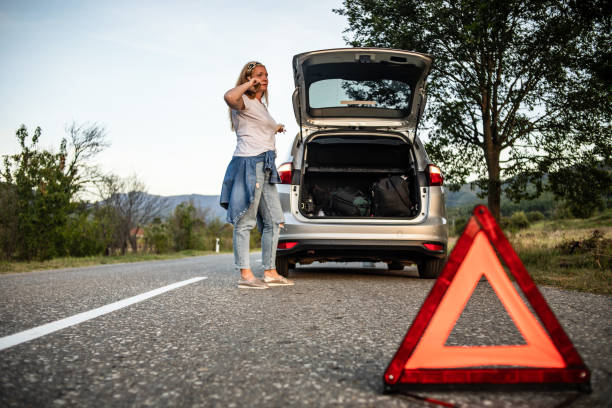Rainy days can turn a routine drive into a challenging adventure. Whether you’re facing a flat tire, a dead battery, or another unexpected vehicle issue, knowing how to handle roadside emergencies in the rain is crucial for staying safe and getting back on the road quickly. In this blog, we’ll explore six essential points for navigating these situations effectively and ensuring you receive the best roadside assistance possible.

Stay Safe and Visible
When faced with a roadside emergency in the rain, your first priority should always be safety. Begin by pulling your vehicle as far off the road as possible to reduce the risk of accidents. Turn on your hazard lights to alert other drivers to your presence, especially in low-visibility conditions. If available, deploy reflective triangles or flares around your vehicle to further increase visibility.
Remember to stay inside your vehicle if it’s safer to do so, especially during heavy rainfall or if you’re on a busy roadway. Exiting your vehicle in dangerous conditions can put you at risk of being struck by passing vehicles.
Wear Reflective Clothing
Wearing reflective clothing is essential during rainy roadside emergencies. It significantly enhances visibility, reducing the risk of accidents, especially in low-light and adverse weather conditions. Reflective materials amplify light from headlights, making you more noticeable to passing vehicles and emergency responders. By donning reflective clothing, you not only increase your safety but also facilitate the timely arrival of roadside assistance. This simple precaution can make a significant difference in ensuring your well-being during roadside emergencies in the rain.
Contact Roadside Assistance Immediately
Once you’ve ensured your safety, it’s time to reach out for professional roadside assistance. Calling for help promptly can minimize your time spent exposed to the elements and expedite the arrival of assistance.
When contacting roadside assistance, provide your exact location and a detailed description of your vehicle’s issue. Mention that you’re experiencing a roadside emergency in the rain so that they can prioritize your request accordingly. Many roadside assistance services offer specialized assistance for inclement weather conditions, such as towing services equipped to handle wet roads and vehicle recovery in adverse weather.
Communicate Clearly and Calmly
Effective communication is key when dealing with roadside assistance providers, especially during stressful situations like inclement weather. Speak clearly and calmly when providing information about your location, vehicle, and the nature of the problem. Avoid exaggerating the severity of the situation but emphasize the urgency of your need for assistance due to the rainy conditions.
If you’re unsure about any details, such as your exact location or the cause of the issue, don’t hesitate to ask for clarification. Providing accurate information ensures that the roadside assistance provider can dispatch the appropriate help quickly and efficiently.
Take Precautions While Waiting
While waiting for roadside assistance to arrive, there are several precautions you can take to ensure your safety and minimize the impact of the rain on your vehicle. If it’s safe to do so, consider exiting your vehicle and waiting in a nearby shelter, such as a gas station or convenience store. This can help keep you dry and reduce exposure to the elements while you wait.
If you must remain in your vehicle, keep the windows closed to prevent rainwater from entering. Use any available blankets or jackets to stay warm and dry, especially if you’re waiting for an extended period. Avoid running the engine excessively to conserve fuel, but ensure that your headlights and hazard lights remain on to maintain visibility.
Keep Your Emergency Kit Handy
Keeping your emergency kit handy is vital during rainy roadside emergencies. Ensure it includes essentials like a flashlight, first aid supplies, a blanket, and non-perishable snacks. These items can provide comfort and assistance while waiting for roadside help. Additionally, consider including items specific to rainy conditions, such as a waterproof poncho or umbrella. Having your emergency kit easily accessible in your vehicle allows you to respond promptly to unexpected situations, enhancing your safety and preparedness on the road, regardless of the weather.
Conclusion
Experiencing a roadside emergency in the rain can be daunting, but with the right preparation and response, you can navigate these situations safely and effectively. By prioritizing safety, contacting roadside assistance promptly, communicating clearly, and taking precautions while waiting, you can minimize the impact of inclement weather on your roadside experience.
Remember, when it comes to rainy roadside emergencies, timely and professional roadside assistance is your best ally. With these tips in mind, you can confidently face whatever challenges the road and weather may throw your way.
FAQ
What are common wet roadside emergencies?
Common wet roadside emergencies include hydroplaning, flat tires due to wet conditions, engine issues from water ingress, and accidents caused by reduced visibility.
How can I avoid hydroplaning in wet conditions?
To avoid hydroplaning, maintain proper tire pressure, slow down in wet weather, avoid sudden braking or turning, and drive in the tracks of the vehicle ahead.
What should I do if my car gets stuck in water or mud?
If your car gets stuck, avoid revving the engine excessively. Instead, try rocking the vehicle gently back and forth, or call for professional towing assistance.
What should I do if my car breaks down in heavy rain?
If your car breaks down, turn on hazard lights, move to a safe location if possible, and call for roadside assistance for prompt help in diagnosing and fixing the issue.
